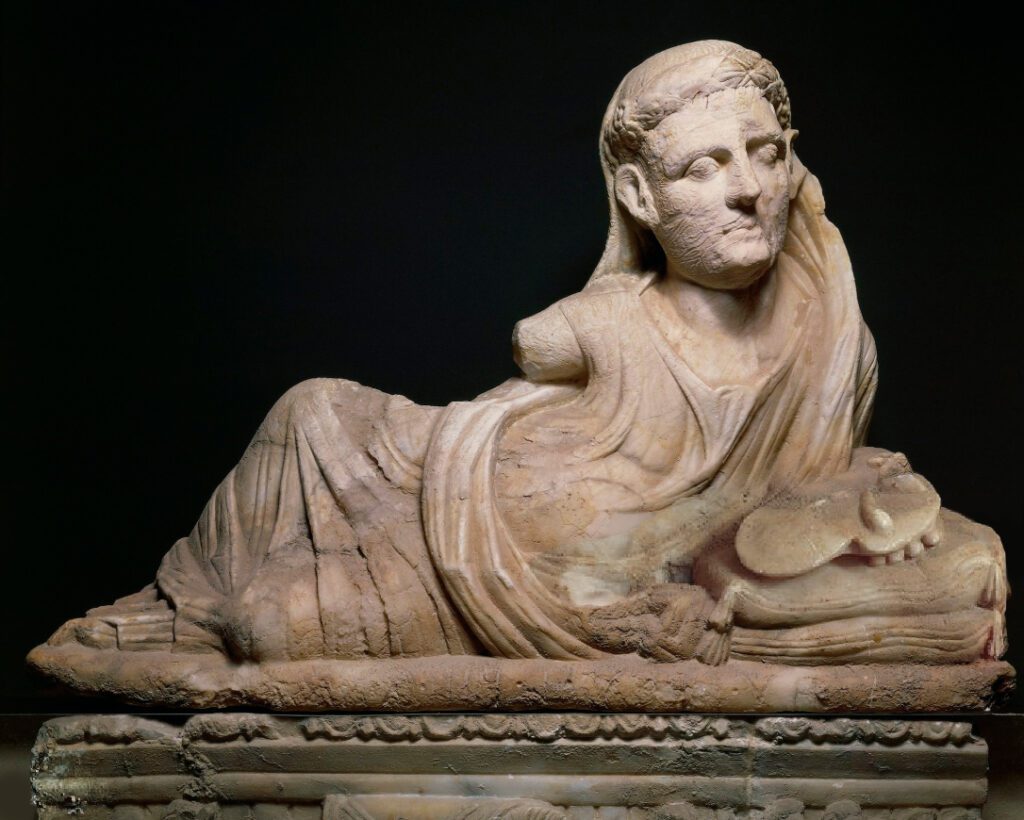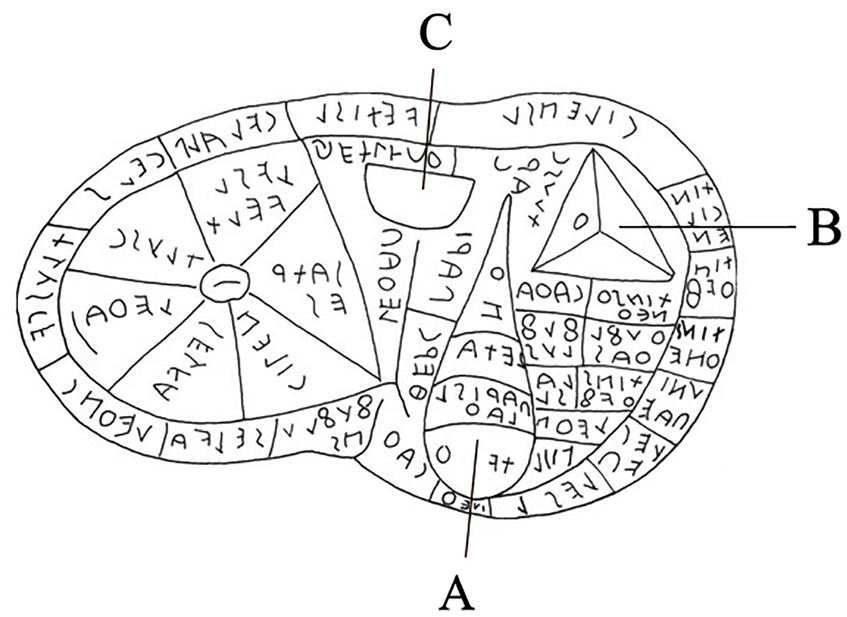Belle van Rosmalen
Thomas van Gulik
Amsterdam, Netherlands

The Palazzo Farnese in the town of Piacenza, Italy houses an archaeological museum called the Musei Civici. Its collection includes an Etruscan model of a sheep’s liver cast in bronze, known as the Piacenza liver.1 (Fig 1) The Etruscans were an ancient civilization with a unique language, culture, and religion. From around 1000 to 30 BC, they lived in an area that today makes up the modern Italian regions of Tuscany, Latium, and Umbria. The Etruscans practiced a polytheistic religion, and one of their rituals included divination through the use of sheep liver.
The liver as the seat of life
The Etruscans had little knowledge of the anatomy and function of the human liver. Yet in Greek mythology, the liver was considered the seat of life in both gods and men, to which religious and mystical properties were attributed.2 The Etruscan oracle, the haruspex, could “read” the future in a sheep’s liver and thereby fulfilled an important societal function. He (women were excluded from this role) foretold the hidden intentions of the gods—and thus the future—by inspecting the liver of a sacrificed sheep.3
The art of “hepatoscopy”

The Etruscan oracle “read” the livers of sheep, by which he could predict the future based on the shape and position of the liver lobes—an art called “hepatoscopy.”3 The bronze liver found in Piacenza served as an instructive model for students who were in training to become haruspex.
The oracle would cut the liver out of the sheep, hold it up in his left hand, and run his right hand over the base of the organ. He would then inspect the liver clockwise. Figure 2 shows a statue of a haruspex on the lid of an urn depicted practicing his craft, holding the liver in his left hand and showing the underside of the organ to the spectator.4 Hence, beholders of this spectacle would view the liver upside down, the convex side of the gallbladder pointing downward instead of up (the position it occupies within the body).
Variable shapes and sizes of the liver lobes and other external features aided the Etruscan haruspex in predicting the future. We examined the bronze liver of Piacenza and compared its external anatomical features with those of ten fresh sheep livers to investigate anatomical variations that were used by the Etruscan haruspex for divination.
Description of the Piacenza liver
The bronze liver of Piacenza measures from 7.5 to 12.5 cm and showcases several characteristic morphological structures (Fig 1). The lower, visceral side of the liver represents the image that the Etruscans had of the universe, including a vast pantheon of gods entrusted with the future (Fig 3).1,5 The surface is divided by lines into quadrants, which in turn are divided into four additional regions. The regions correspond with the dominions of the gods in the universe, according to their names engraved in the bronze model. The gallbladder, for example, is inscribed with the name of Neptune, the water god, to whom this reservoir of watery bile was dedicated. In a band around the bronze liver, sixteen smaller regions were delineated that were connected to the gods in the central regions. In this way, the Etruscans assigned each god a place on their map of the universe, projected onto a sheep’s liver.
Comparison of the Piacenza liver with human anatomy

The pear-shaped structure positioned at the center of the model is the gallbladder (Fig 3A). Whereas the convex part of the human gallbladder is usually represented at the front and upper side of the liver, the liver in the Etruscan model is reversed, with the convex part of the gallbladder pointing down—this is if one uses the inscribed letters as an orientation guide or instruction on how to hold the model. As described above (Fig 2), the reversed representation of the gallbladder is explained by the way the haruspex would hold the liver in his hand, offering spectators an upside-down view of its visceral side.
On the right side of the gallbladder, we find a pyramid-shaped structure that is referred to as the processus pyramidalis (Fig 3B). This structure anatomically corresponds with the caudate lobe in humans, a small lobe on the backside of the liver with a spur that reaches into the anatomical right lobe.6 On the other side of the gallbladder, the bronze liver shows a protrusion shaped like a semi-circle (Fig 3C) that is called the processus papillaris and corresponds—in humans—with the anatomical extension of the caudate lobe adjacent to the caval vein, known as the paracaval portion of the caudate lobe.
The three anatomical landmarks, i.e. the gallbladder, the processus pyramidalis, and processus papillaris can also be found on clay models of sheep livers found in Babylonian civilizations from 1,500 years earlier in the town of Mari in ancient Syria.7,8 These clay models were also used for telling the future. In the Babylonian liver, the processus pyramidalis is prominent as a prism-shaped protrusion to the left of the gallbladder.
Anatomical findings in fresh sheep livers

Ten livers were excised from adult sheep at an artisanal meat-processing farm in the Netherlands (Baambrugge) and inspected in the same way as the haruspex. While the livers were held in the left hand, the anatomical details were documented.
The external features of the sheep’s liver were readily identified. (Fig 4) The variation among the ten livers studied was remarkable: the processus pyramidalis (Fig 4B) consistently showed three triangular planes in each liver but greatly varied in size and length. The processus papillaris (Fig 4C) showed the most variation: it could be large, small, with or without ridges and, in one liver, it was absent altogether. In two livers, the processus papillaris presented in duplicate.
Anatomical reference points for the haruspex
The protrusions on the lower side of the liver, the processus pyramidalis and the processus papillaris, formed two points of reference during “hepatoscopy.” The art of predicting the future was based on the presence and shape of these protrusions. Pliny the Elder, the famed Roman encyclopedist, described these two structures, writing that they could vary greatly in appearance.3 The processus pyramidalis¸ also called the caput¸ was the most significant structure in the construction of fortunes. If the processus pyramidalis was absent, this was seen as a bad omen. If either of the two protrusions appeared in duplicate, however, this was seen as a good sign and a promise of prosperity. When important decisions had to be made, such as the beginning of a military campaign or starting a voyage, a haruspex and liver “reading” would place the final decision in the hands of the gods.
If the processus papillaris was absent, this was also considered a bad omen by the Etruscans. The one missing processus papillaris among the examined sheep livers was, fortunately, countered by two other livers where it presented in duplicate! It goes without saying that the haruspex was extremely skilled at recognizing the anatomical varieties in sheep livers. He had to be, because the Etruscan future largely depended on his divinations.
References
- Meer, LB van der. (1987). The bronze liver of Piacenza. JC Gieben, Amsterdam.
- Van Rosmalen JM, Van Gulik MM, Van Rosmalen BV, Van Gulik TM. (2022). Prometheus and the Liver, through Art and Medicine. Amsterdam University Press, Amsterdam. library.oapen.org/handle/20.500.12657/53539
- MacIntosh Turfa J, Gettys S. (2009). The skill of the Etruscan Haruspex. A biological basis for successful divination? BABESCH 84:41-52. doi: 10.21037/hbsn-2021-17
- Etruscan Museum Guarnacci, The Collection of Etruscan Urns, Volterra, Italy. https://volterratur.it/en/poi/guarnacci-etruscan-museum/
- Olmsted D. (2021). Translation of Bronze Etruscan Piacenza Liver Reveals Liver Divination Practices (400 BCE), Knowledge Commons. http://dx.doi.org/10.17613/973y-7767
- Van Gulik TM, Lang H. (2005). Isolated resection of segment 1 of the liver. Dig Surg 22:143-148. doi.org/10.1159/000087131
- Cavalcanti de A, Martins A, Martins C. (2013). History of liver anatomy: Mesopotamian liver clay models. HPB 15:322-323. doi: 10.1111/j.1477-2574.2012.00555.x
- Michel C. (2015). Ein Manuskript in Form einer Schafsleber?, in: Andreas Janke (red.), Manuskript des Monat, 10, SFB 950: Hamburg. https://www.csmc.uni-hamburg.de/publications/aom/mom/46-de.html
Acknowledgements
The authors wish to thank L.M. van der Meer, archeologist at the University of Leiden, for his valuable advice and support.
BELLE VAN ROSMALEN completed her PhD thesis at Amsterdam University Medical Center, University of Amsterdam.
THOMAS VAN GULIK is Prof.em. of Surgery at Amsterdam University Medical Center, University of Amsterdam, The Netherlands.

Leave a Reply